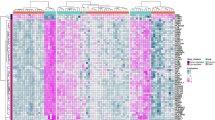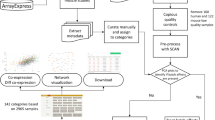Abstract.
The primary cause of Duchenne muscular dystrophy (DMD) is a mutation in the dystrophin gene, leading to absence of the corresponding protein, disruption of the dystrophin-associated protein complex, and substantial changes in skeletal muscle pathology. Although the primary defect is known and the histological pathology well documented, the underlying molecular pathways remain in question. To clarify these pathways, we used expression microarrays to compare individual gene expression profiles for skeletal muscle biopsies from DMD patients and unaffected controls. We have previously published expression data for the 12,500 known genes and full-length expressed sequence tags (ESTs) on the Affymetrix HG-U95Av2 chips. Here we present comparative expression analysis of the 50,000 EST clusters represented on the remainder of the Affymetrix HG-U95 set. Individual expression profiles were generated for biopsies from 10 DMD patients and 10 unaffected control patients. Two methods of statistical analysis were used to interpret the resulting data (t-test analysis to determine the statistical significance of differential expression and geometric fold change analysis to determine the extent of differential expression). These analyses identified 183 probe sets (59 of which represent known genes) that differ significantly in expression level between unaffected and disease muscle. This study adds to our knowledge of the molecular pathways that are altered in the dystrophic state. In particular, it suggests that signaling pathways might be substantially involved in the disease process. It also highlights a large number of unknown genes whose expression is altered and whose identity therefore becomes important in understanding the pathogenesis of muscular dystrophy.
Similar content being viewed by others
References
Engel AG, Banker BQ (1986) Myology. McGraw-Hill, New York
Ehmsen J, Poon E, Davies K (2002) The dystrophin-associated protein complex. J Cell Sci 115:2801–2803
Matsumura K, Campbell KP (1994) Dystrophin-glycoprotein complex: its role in the molecular pathogenesis of muscular dystrophies. Muscle Nerve 17:2–15
Straub V, Campbell KP (1997) Muscular dystrophies and the dystrophin-glycoprotein complex. Curr Opin Neurol 10:168–175
Hack AA, Cordier L, Shoturma DI, Lam MY, Sweeney HL, McNally EM (1999) Muscle degeneration without mechanical injury in sarcoglycan deficiency. Proc Natl Acad Sci U S A 96:10723–10728
Bushby KM (1999) The limb-girdle muscular dystrophies-multiple genes, multiple mechanisms. Hum Mol Genet 8:1875–1882
Nishino I, Ozawa E (2002) Muscular dystrophies. Curr Opin Neurol 15:539–544
Porter JD, Khanna S, Kaminski HJ, Rao JS, Merriam AP, Richmonds CR, Leahy P, Li J, Guo W, Andrade FH (2002) A chronic inflammatory response dominates the skeletal muscle molecular signature in dystrophin-deficient mdx mice. Hum Mol Genet 11:263–272
Rouger K, Le Cunff M, Steenman M, Potier MC, Gibelin N, Dechesne CA, Leger JJ (2002) Global/temporal gene expression in diaphragm and hindlimb muscles of dystrophin-deficient (mdx) mice. Am J Physiol Cell Physiol 283:C773–C784
Tkatchenko AV, Le Cam G, Leger JJ, Dechesne C A (2000) Large-scale analysis of differential gene expression in the hindlimb muscles and diaphragm of mdx mouse. Biochim Biophys Acta 1500:17–30
Tkatchenko AV, Pietu G, Cros N, Gannoun-Zaki L, Auffray C, Leger JJ, Dechesne CA (2001) Identification of altered gene expression in skeletal muscles from Duchenne muscular dystrophy patients. Neuromuscul Disord 11:269–277
Tseng BS, Zhao P, Pattison JS, Gordon SE, Granchelli JA, Madsen RW, Folk LC, Hoffman EP, Booth FW (2002) Regenerated mdx mouse skeletal muscle shows differential mRNA expression. J Appl Physiol 93:537–545
Bakay M, Chen YW, Borup R, Zhao P, Nagaraju K, Hoffman EP (2002) Sources of variability and effect of experimental approach on expression profiling data interpretation. Bioinformatics 3:4
Chen YW, Zhao P, Borup R, Hoffman EP (2000) Expression profiling in the muscular dystrophies: identification of novel aspects of molecular pathophysiology. J Cell Biol 151:1321–1336
Haslett JN, Sanoudou D, Kho AT, Bennett RR, Greenberg SA, Kohane IS, Beggs AH, Kunkel LM (2002) Gene expression comparison of biopsies from Duchenne muscular dystrophy (DMD) and normal skeletal muscle. Proc Natl Acad Sci U S A 99:15000–15005
Butte AJ, Ye J, Haring HU, Stumvoll M, White MF, Kohane IS (2001) Determining significant fold differences in gene expression analysis. Pac Symp Biocomput 6–17
Tamayo P, Slonim D, Mesirov J, Zhu Q, Kitareewan S, Dmitrovsky E, Lander ES, Golub TR (1999) Interpreting patterns of gene expression with self-organizing maps: methods and application to hematopoietic differentiation. Proc Natl Acad Sci U S A 96:2907–2912
Zhao Q, Kho A, Kenney AM, Yuk Di DI, Kohane I, Rowitch DH (2002) Identification of genes expressed with temporal-spatial restriction to developing cerebellar neuron precursors by a functional genomic approach. Proc Natl Acad Sci U S A 99:5704–5709
Press WH, Teukolsky SA, Vetterling WT, Flannery BP (1992) Numerical recipes: the art of scientific computing. Cambridge University Press, Cambridge
Pritchard CC, Hsu L, Delrow J, Nelson PS (2001) Project normal: defining normal variance in mouse gene expression. Proc Natl Acad Sci U S A 98:13266–13271
Rando TA (2001) The dystrophin-glycoprotein complex, cellular signaling, and the regulation of cell survival in the muscular dystrophies. Muscle Nerve 24:1575–1594
Acknowledgements.
We would like to thank Drs. Hart G.W. Lidov, Emmanuela Gussoni, and Steven A. Greenberg for providing some of the patient biopsies. We would also like to thank members of the Kunkel laboratory and Paul Beswick for helpful discussions. This work was supported by grants from the NIH (NS40828–01A1) (I.S.K., A.H.B., and L.M.K.), the Muscular Dystrophy Association (A.H.B. and L.M.K.), the NIAMS (R01 AR44349) (A.H.B.), the NHLBI (U 01 HL066582-01) (I.S.K.), and the Bernard F. and Alva B. Gimbel Foundation (L.M.K.).
Author information
Authors and Affiliations
Corresponding author
Electronic supplementary material
Rights and permissions
About this article
Cite this article
Haslett, J.N., Sanoudou, D., Kho, A.T. et al. Gene expression profiling of Duchenne muscular dystrophy skeletal muscle. Neurogenetics 4, 163–171 (2003). https://doi.org/10.1007/s10048-003-0148-x
Received:
Accepted:
Published:
Issue Date:
DOI: https://doi.org/10.1007/s10048-003-0148-x




